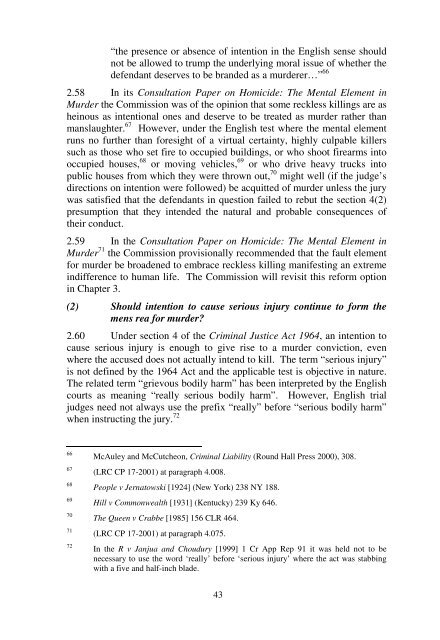murder and involuntary manslaughter - Law Reform Commission
murder and involuntary manslaughter - Law Reform Commission
murder and involuntary manslaughter - Law Reform Commission
You also want an ePaper? Increase the reach of your titles
YUMPU automatically turns print PDFs into web optimized ePapers that Google loves.
“the presence or absence of intention in the English sense shouldnot be allowed to trump the underlying moral issue of whether thedefendant deserves to be br<strong>and</strong>ed as a <strong>murder</strong>er…” 662.58 In its Consultation Paper on Homicide: The Mental Element inMurder the <strong>Commission</strong> was of the opinion that some reckless killings are asheinous as intentional ones <strong>and</strong> deserve to be treated as <strong>murder</strong> rather than<strong>manslaughter</strong>. 67 However, under the English test where the mental elementruns no further than foresight of a virtual certainty, highly culpable killerssuch as those who set fire to occupied buildings, or who shoot firearms intooccupied houses, 68 or moving vehicles, 69 or who drive heavy trucks intopublic houses from which they were thrown out, 70 might well (if the judge’sdirections on intention were followed) be acquitted of <strong>murder</strong> unless the jurywas satisfied that the defendants in question failed to rebut the section 4(2)presumption that they intended the natural <strong>and</strong> probable consequences oftheir conduct.2.59 In the Consultation Paper on Homicide: The Mental Element inMurder 71 the <strong>Commission</strong> provisionally recommended that the fault elementfor <strong>murder</strong> be broadened to embrace reckless killing manifesting an extremeindifference to human life. The <strong>Commission</strong> will revisit this reform optionin Chapter 3.(2) Should intention to cause serious injury continue to form themens rea for <strong>murder</strong>?2.60 Under section 4 of the Criminal Justice Act 1964, an intention tocause serious injury is enough to give rise to a <strong>murder</strong> conviction, evenwhere the accused does not actually intend to kill. The term “serious injury”is not defined by the 1964 Act <strong>and</strong> the applicable test is objective in nature.The related term “grievous bodily harm” has been interpreted by the Englishcourts as meaning “really serious bodily harm”. However, English trialjudges need not always use the prefix “really” before “serious bodily harm”when instructing the jury. 7266676869707172McAuley <strong>and</strong> McCutcheon, Criminal Liability (Round Hall Press 2000), 308.(LRC CP 17-2001) at paragraph 4.008.People v Jernatowski [1924] (New York) 238 NY 188.Hill v Commonwealth [1931] (Kentucky) 239 Ky 646.The Queen v Crabbe [1985] 156 CLR 464.(LRC CP 17-2001) at paragraph 4.075.In the R v Janjua <strong>and</strong> Choudury [1999] 1 Cr App Rep 91 it was held not to benecessary to use the word ‘really’ before ‘serious injury’ where the act was stabbingwith a five <strong>and</strong> half-inch blade.43
















